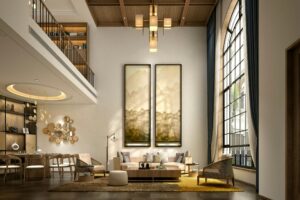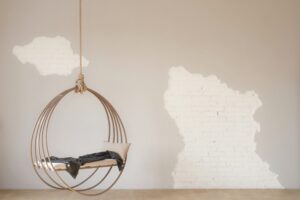 When you first walk into a living space – an elegant colonial house, an eclectic bungalow, even a rustic cabin – your perception of it is undoubtedly swayed by an element that complements all the others. Art is an essential part of interior design, a powerful tool that can add personality, depth and vibrancy to any space.
When you first walk into a living space – an elegant colonial house, an eclectic bungalow, even a rustic cabin – your perception of it is undoubtedly swayed by an element that complements all the others. Art is an essential part of interior design, a powerful tool that can add personality, depth and vibrancy to any space.
Whether it’s a grand oil painting above a fireplace, a sleek modern sculpture in a corner, or an intricately crafted vase atop a coffee table, art has the ability to transform an environment. By thoughtfully considering various forms of art, you can create a unique aesthetic that perfectly enhances a space’s architecture, design and lighting.
Choosing Among Art Forms
From classical oil canvases to contemporary watercolor pieces, paintings and prints can set the mood of a room or an entire home. Larger paintings act as focal points, drawing attention and creating a dramatic effect, while smaller pieces can punctuate more intimate spaces, such as a bathroom wall or dressing area. Think about style, color palette and framing (ornate or simple). Then there’s budget – and original paintings and limited-edition prints can often be found for a reasonable price at local art fairs, student art shows and online shops like Etsy and Saatchi Art.
For those who appreciate texture and dimension, mixed-media art can serve as a compelling alternative to traditional paintings. These pieces incorporate various materials such as fabric, metal and paper, adding a tactile element that interacts with the room’s lighting and ambiance. Assemblage artwork brings an added three-dimensionality, often through the use of found objects such as reclaimed wood, while photo transfer art can also use wood as a pop-out background for a unique photograph.
When we think about bringing a three-dimensional presence to interior spaces, however, it’s also beneficial to look beyond walls. Sculptures – whether classic marble busts, abstract metal works or organic wooden forms – add genuine depth and character. They can be placed on a table, a piano or a pony wall, integrated into built-in niches, or even serve as statement pieces at the center of a room.
Decorative vases and pottery aren’t just functional; they contribute to the aesthetic of a home. Handcrafted ceramic, glass or porcelain vases add elegance and interest to shelves, tables and mantels, and fresh or dried floral arrangements deliver height and natural appeal. Along with antique shops and local galleries, do-it-yourself pottery classes have grown in popularity with the lure of creative expression, mindfulness and social connection.
Wall tapestries, woven textiles and fiber pieces can serve a dual purpose in filling larger spaces and incorporating a softer, more organic feel. These add warmth and charm to a space and can be particularly effective in areas where sound absorption is needed, such as large open rooms.
Selecting Art to Complement a Space
Choosing the best artwork for an environment can be a daunting task. But it always begins with consideration of these basics:
- Space and Scale – Take both the macro view (an entire home) and the micro view (one room or one connected area). The size of artwork should be proportionate to the space. A large painting can overwhelm a small room, while a tiny piece may get lost on a huge empty wall, especially in a room with a vaulted or cathedral ceiling.
- Style and Personal Taste – Ultimately, it comes down to this. Art is deeply personal, so choosing pieces that resonate with aesthetic preferences is key. Whether a homeowner leans toward classical or impressionist, bare minimalism or detailed eclecticism, artwork should align with the same vision.
- Budget Considerations – As indicated, while original art pieces can be big investments, there are many affordable options such as prints, replicas or the work of emerging artists that can deliver the same impact. Mixing high-end pieces with budget-friendly finds can also create a well-balanced, stylish and affordable look.
Enhancing Art with Lighting
Lighting can maximize the beauty of artwork. Some of the world’s best-known museums, from the Museum of Contemporary Art in Chicago to the Tate Modern in London, use automated ceiling louvers to continually manage the shifting of natural light in exhibition areas. For more modest private homes, consider the following to shine a light on art:
- Picture lights: Mounted directly above paintings to ensure details can be easily seen
- Track lighting: Ideal for highlighting paintings and sculptures, providing adjustable illumination across a room
- Wall sconces: An ambient glow that softly illuminates art pieces
- Natural light: Be mindful of exposure, as direct sunlight can cause fading over time
Harmonizing with Other Elements
A grand piano in the middle of a small room would be out of proportion – and overly loud. Similarly, art should integrate seamlessly with other design elements in a space, like a center custom furniture piece or other elements. If dark furniture dominates a room, for example, balance it with light and bright artwork, metallic elements to add shine, or nature-inspired landscapes with complementary lush greens and soft blues. Work to ensure a cohesive look by pairing artwork with a room’s textiles, woods, mirrors and other materials. Choose art to beautifully enhance, or purposely contrast, a room’s color palette.
And remember that incorporating art into interior design is an art form in itself, requiring a balance between creativity and strategy. Art doesn’t just decorate a room – it tells a story, evokes emotions, and creates an atmosphere that makes a house truly feel like home.




Leave a Reply